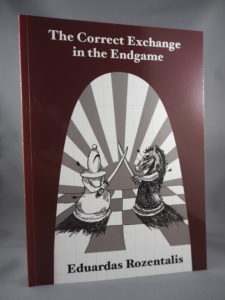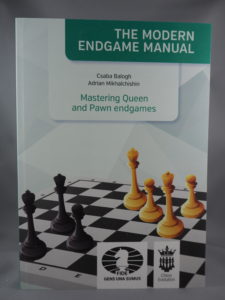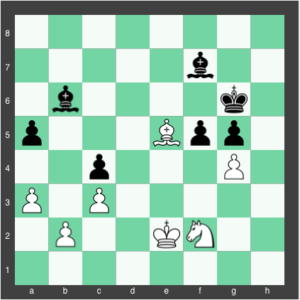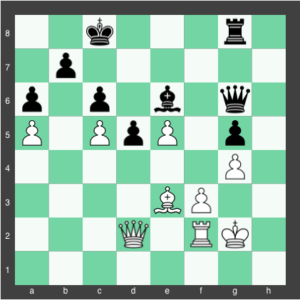Just over half way into the 2016 World Chess Championship and we have just seen the first dent with the score 4.5 to challenger Karjakin against 3.5 for Magnus Carlsen. Before this we had seven rounds resulting in seven draws.
Have you read our earlier blog about the World Chess Championships?
So how important is it to know your endgames (and are draws really so dull)?
If one thing has come out of the contest so far it’s that the Russian challenger Sergey Karjakin is tough to beat, even for a world champion.
Despite being under pressure in several games, he has managed to scrape by in some worse endgames, reinforcing what most amateur players already know: we need to practice our endgames more if we really want to improve.
On the other hand, even Carlsen himself has admitted to not playing his best, which, for the world champion, is something close to unstoppable. Notorious for ‘warming up’ throughout a tournament, it’s still possible we’ll see the infamous Carlsen steamroll in action, but so far Karjakin’s knowledge of the game has proved too much.

So what can amateurs like us learn from watching such elite level players compete? In particular, intermediate level players should note the importance of making a draw in a slightly worse position. Getting that half point rather than letting your opponent win in a better position can be a big ask, but the score board will thank you for your efforts.
There’s no better way to improve your general play than to study endgames. Winning with two bishops against a knight and bishop is one of the most important to study, as it happens frequently, and knowing what positions favour the bishops can make the difference between a winning and drawn endgame.
Rook and minor piece endgames are also common, though tricky, and should be studied after rook and pawn endgames (which in themselves are pretty tricky).
There are not many End game books available if you want to study more, but Thinkers Publishing has ‘The Correct Exchange in the Endgame’ and Evolution Chess provides ‘The Modern Endgame Manual’ and “Most interesting draws 2012-2015’, which are all available in our store.
Of course there’s nothing better for improving your game than having a professional chess coach tailor a study plan to your specific strengths and weaknesses.
What do draws mean for the World Chess Championship?
Up to round seven there were only draws and this unexpectedly tied score comes with significant mistakes being made by both players, as well as staunch defending by the challenger Sergey Karjakin.
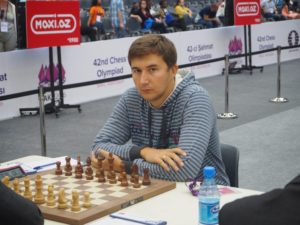
Uncharacteristically, champion Magnus Carlsen has been unable to push for a win in the several advantageous positions he has held, instead being rebuffed by Karjakin’s typically stalwart play.
Game one saw the champ opening with the never-before-seen in a championship game Trompowsky attack (a conceded reference to the U.S. president-elect). Karjakin was able to hold a slightly worse position, an auspicious foreshadowing of the games to come.
Game two was a dry Ruy Lopez, ending with both players unable to make progress with two knights and a rook against an equal number of pawns on the same side of the board.
Game three, however, saw the champ once again pressing in the famously equal Berlin opening, leading Karjakin to make a slight error under pressure, probably exhausted at the 70th move in the game. Luckily his Norwegian opponent missed his chance to win and the players agreed to a draw eight moves later.
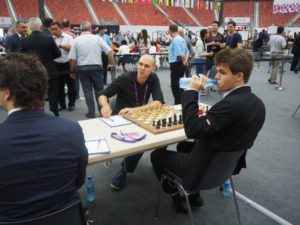
Game four saw an unusual decision by the Russian player in giving up the two bishops, leading into an endgame with potential weaknesses on both sides of the board.
In the position below, Carlsen’s bishops look menacing, threatening to dash across the board at any sign of weakness. Carlsen, however, chose to close the kingside with 45 …f4, a move which he admitted later was a mistake.
Looking for further weaknesses was a better option, with a move like Be6 increasing the pressure while leaving open the possibility to attack on both sides of the board.
The tough endgames continued in game five, this time with Karjakin coming out of the opening with chances to win. In the position below he played the cool move 42 …d4, allowing Carlsen to take his pawn in order to free up a better square for his bishop and gain a strategic advantage.
His upper hand was short-lived, however, when a couple of moves later the game again became equal with Karjakin allowing Carlsen to take control of the h-file with his rook.
Despite being ultimately unable to convert his advantage to a win, the game was nevertheless a good sign for the challenger, and left open the possibility that things might just turn in his favour.
No doubt exhausted, the players went into a rest day early with a ‘quick game’ in round six, ending in a draw after ‘only’ 95 minutes of play.
New watching format hit and miss with subscribers
Meanwhile, chess fans who have subscribed to organiser Agon‘s new pay-per-view platform have been enjoying the first ever 3D chess-viewing experience. Reviews, however, have been tainted by some temporary losses of service.
Some of the Adelaide Hills Chesslife students enjoyed an early morning analysis of game one, thanks to head coach David Koetsier, who provided a running commentary and breakfast at this home.
Stay tuned for further updates on the 2016 World Chess Championship.

